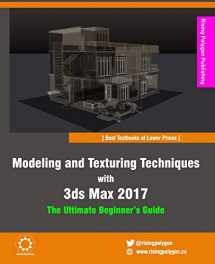
Modeling and Texturing Techniques with 3ds Max 2017: The Ultimate Beginner's Guide
Book details
Summary
Description
Why this Book?The Modeling and Texturing Techniques with 3ds Max 2017 - The Ultimate Beginner’s Guide, 2nd Edition textbook offers a hands-on exercises based strategy for all those digital artists who have just started working on the 3ds Max and interested in learning modeling and texturing in 3ds Max. This brilliant guide takes you step-by-step through the whole process of modeling and texturing. From the very first pages, the users of the book will learn how to effectively use 3ds Max for hard surface modeling and shading surfaces.
What you need?To complete the examples and hands-on exercises in this book, you need 2017 version of Autodesk 3ds Max.
What are the main features of the book?The book is written using 3ds Max 2017 in an easy to understand language.Polygon and Spline modeling techniques covered.All modifiers explained.Shading and texturing techniques covered.65 Hands-on exercises to hone your skills.Detailed coverage of tools and features.Additional tips, guidance, and advice is provided.Important terms are in bold face so that you never miss them.Support for technical aspect of the book.3ds Max files and textures used are available for download from the accompanying website.
Is this book is available in e-Book format?Yes. You can download the color e-Book from the Amazon’s Kindle store.
How This Book Is Structured?This book is divided into following units:
Unit MI1 - Introduction to 3ds Max - INavigating the workspaceCustomizing the interfaceUnderstanding various UI componentsWorking with the file management commandsSetting preferences for 3ds MaxUnderstanding workspacesUnderstanding the enhanced menu systemWorking with viewportsSetting preferences for the viewportsCreating objects in the sceneSelecting objectsUsing the navigational gizmosMoving, rotating, and scaling objectsGetting helpPer-view Preferences, Creative Market Store, Asset Library, Print Studio, and Game Exporter
Unit MI2 - Introduction to 3ds Max - IIWorking with templatesCreating clones and duplicatesUnderstanding hierarchiesWorking with the Scene and Layer ExplorersUnderstanding the Mirror tool, the Select and Place tool, and the Select and Manipulate toolWorking with the Align tool and the Array toolWorking with precision and drawing aidsUnderstanding modifiers, and normals
Unit MM1 - Working with Geometric Primitives and Architectural ObjectsCreating and modifying Standard PrimitivesCreating and modifying Extended PrimitivesWorking with the Architectural objectsSetting the project folderUsing the Align and Mirror toolsCreating clonesUsing the Scene ExplorerCreating a groupSetting grid spacingsUsing Transform Type-In dialogUsing Array dialogSpecifying units for the scene
Unit MM2: Working with PolygonsWorking with the polygon modeling toolsUsing the polygon modeling techniquesSelecting polygon sub-objectTransforming sub-objectsSoft selecting sub-objects
Unit MM3: Graphite Modeling Tools Working with the Graphite Modeling ToolsSelecting sub-objectsCreating models using the tools available in the Ribbon
Unit MM4: Working with ShapesGenerate planar and 3d surfacesPaths and shapes for the loft componentsGenerate extrusionsGenerate revolved surfacesDefine motion path for animations
Unit MM5: ModifiersUsing modifiersStack displayObject-space modifiers vs World-space modifiersHow transform affects modifiersDeformers
Unit MBME1: Bonus Hands-on Exercises
Unit MT1 - Material EditorsCompact Material EditorSlate Material Editor
Unit MT2 - General/Scanline Materials and MapsGeneral/Scanline materialsGeneral maps
Unit MT3 - Physical, mental ray, and Autodesk MaterialsAutodesk MaterialsArch & Design MaterialPhysical Material


We would LOVE it if you could help us and other readers by reviewing the book
Book review



